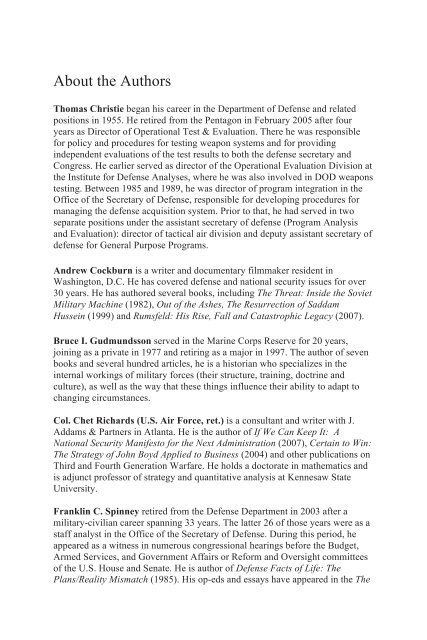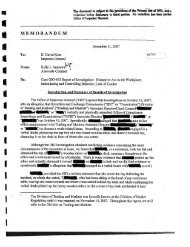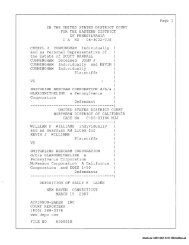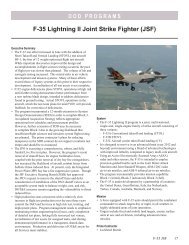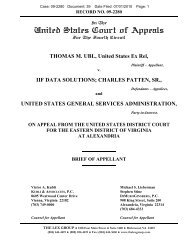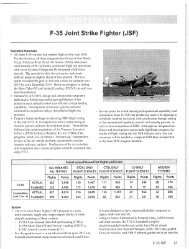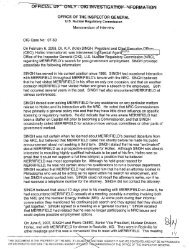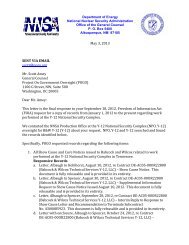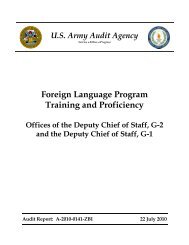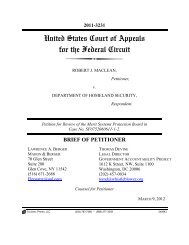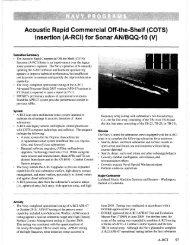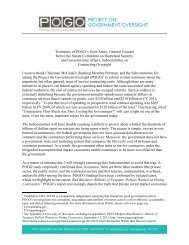The Pentagon Labyrinth
The Pentagon Labyrinth
The Pentagon Labyrinth
Create successful ePaper yourself
Turn your PDF publications into a flip-book with our unique Google optimized e-Paper software.
About the Authors<br />
Thomas Christie began his career in the Department of Defense and related<br />
positions in 1955. He retired from the <strong>Pentagon</strong> in February 2005 after four<br />
years as Director of Operational Test & Evaluation. <strong>The</strong>re he was responsible<br />
for policy and procedures for testing weapon systems and for providing<br />
independent evaluations of the test results to both the defense secretary and<br />
Congress. He earlier served as director of the Operational Evaluation Division at<br />
the Institute for Defense Analyses, where he was also involved in DOD weapons<br />
testing. Between 1985 and 1989, he was director of program integration in the<br />
Office of the Secretary of Defense, responsible for developing procedures for<br />
managing the defense acquisition system. Prior to that, he had served in two<br />
separate positions under the assistant secretary of defense (Program Analysis<br />
and Evaluation): director of tactical air division and deputy assistant secretary of<br />
defense for General Purpose Programs.<br />
Andrew Cockburn is a writer and documentary filmmaker resident in<br />
Washington, D.C. He has covered defense and national security issues for over<br />
30 years. He has authored several books, including <strong>The</strong> Threat: Inside the Soviet<br />
Military Machine (1982), Out of the Ashes, <strong>The</strong> Resurrection of Saddam<br />
Hussein (1999) and Rumsfeld: His Rise, Fall and Catastrophic Legacy (2007).<br />
Bruce I. Gudmundsson served in the Marine Corps Reserve for 20 years,<br />
joining as a private in 1977 and retiring as a major in 1997. <strong>The</strong> author of seven<br />
books and several hundred articles, he is a historian who specializes in the<br />
internal workings of military forces (their structure, training, doctrine and<br />
culture), as well as the way that these things influence their ability to adapt to<br />
changing circumstances.<br />
Col. Chet Richards (U.S. Air Force, ret.) is a consultant and writer with J.<br />
Addams & Partners in Atlanta. He is the author of If We Can Keep It: A<br />
National Security Manifesto for the Next Administration (2007), Certain to Win:<br />
<strong>The</strong> Strategy of John Boyd Applied to Business (2004) and other publications on<br />
Third and Fourth Generation Warfare. He holds a doctorate in mathematics and<br />
is adjunct professor of strategy and quantitative analysis at Kennesaw State<br />
University.<br />
Franklin C. Spinney retired from the Defense Department in 2003 after a<br />
military-civilian career spanning 33 years. <strong>The</strong> latter 26 of those years were as a<br />
staff analyst in the Office of the Secretary of Defense. During this period, he<br />
appeared as a witness in numerous congressional hearings before the Budget,<br />
Armed Services, and Government Affairs or Reform and Oversight committees<br />
of the U.S. House and Senate. He is author of Defense Facts of Life: <strong>The</strong><br />
Plans/Reality Mismatch (1985). His op-eds and essays have appeared in the <strong>The</strong>


